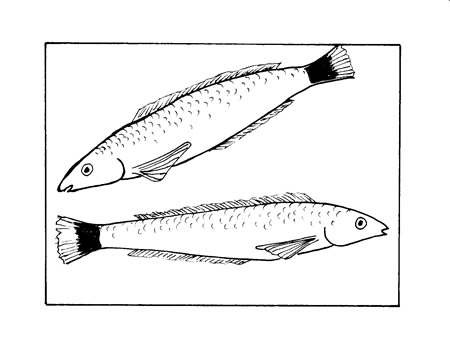Consider the Bonita Chiquita Señorita

A fish abundantly found in the waters of Laguna Beach is the señorita (Oxyjulis californica). With its two other locally found relatives, the California sheephead and the rock wrasse, it belongs to the second largest family of marine fishes, the wrasses. They inhabit the open water around rocky reefs and kelp and are found all year long at depths of less than 75 feet. Distributed from Salt Point in Northern California to Cedros Island in Baja California, they are abundantly found in Laguna Beach either singly, in groups or in dense schools. Their body is fusiform (cigar) shaped, long, slender and tapering at both ends. Thought to live between four to seven years, they reach a maximum size of 10 inches. Adult señoritas are shiny and their coloring ranges from a bronze, orangey yellow on the top of their body, which fades to a pale, almost white belly. They have small protruding teeth in their small mouth and a large black spot at the base of their tail. Like all members of the wrasse family, the señorita mainly uses its pectoral fins, the pair of fins located just behind the head with one on each side of its body, to propel itself through the water.
Unlike many species of the wrasse which are hermaphrodites, señoritas have no sex reversal, thus are born as the sex they maintain throughout their life. Pelagic spawning (broadcast spawning) is thought to occur between May and August with the fish releasing eggs into the open water where they are externally fertilized. Floating for a period of time in the water column, they develop into planktonic larvae for about one month before appearing from June to early November as less than one inch long juvenile fish that are almost transparent except for the black spot at the base of their tail. Living in schools just under the surface of the water near the kelp canopy, the señorita continues to develop and grow until it reaches sexual maturity at about one year of age.

Primarily carnivores, their diet consists of zooplankton that they capture in the current and small invertebrates such as limpets, snails, crustaceans and worms that they remove from the kelp. As such, they are considered key members of a healthy kelp forest ecosystem. In addition, the señorita is a cleaner that feeds on the ectoparasites, copepods and other material living on the bodies of other, sometimes predatory fish including bat rays, Garibaldis, sargos and giant sea bass that appear to seek them out for grooming. In fact, when señoritas start grooming one fish, other fish will gather around and await their turn. Daytime feeders, the fish retreat at sunset to the ocean floor and bury themselves tail first so that just their head remains above the sand only to emerge at dawn. They also exhibit this behavior to escape predators, which include the California sea lion, harbor seals and Brandt’s cormorant and occasionally kelp bass, starry rockfish and bocaccio. Although the señorita is edible, it is not considered a human food fish because of its small size. There is no commercial market for the fish other than for aquarium trade.
Local residents Mia Davidson and Jan Sattler write about their observations as ocean swimmers.





[…] Source […]